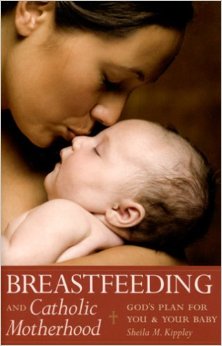 Breastfeeding and Catholic Motherhood: God’s Plan for You and Your Baby by Sheila M. Kippley is a slender volume with a wealth of information on both breastfeeding and Catholic teachings. Sheila writes from personal experience as well as over forty years of research. She is honest and encouraging with an easy-to-read style that leaves the reader much to think about.
Breastfeeding and Catholic Motherhood: God’s Plan for You and Your Baby by Sheila M. Kippley is a slender volume with a wealth of information on both breastfeeding and Catholic teachings. Sheila writes from personal experience as well as over forty years of research. She is honest and encouraging with an easy-to-read style that leaves the reader much to think about.
Kippley presents the medical and scientific research to support breastfeeding. She says, “When a mother nourishes a baby at her breasts, she provides a safe and protective environment and the gift of her own personal presence, so important during the early years.”She explains the health benefits of breastfeeding for the baby (including long-term benefits such as higher IQ scores and stronger immune systems) and the mother (including reduced risk of developing osteoporosis and ovarian cancer).
In chapter two, Kippley discusses the importance of the first years of the baby’s life and delves into the emotional benefits of breastfeeding (again, for both mother and baby), such as the way that breastfeeding stimulates “happy hormones.” She explains that, “babies thrive on maternal intimacy.”
Kippley then turns to the spiritual benefits of breastfeeding. She shares the teachings of popes who have supported breastfeeding, including Pope Pius XII (who addressed mothers during World War II) and Pope John Paul II (who addressed the UN). Other bishops and priests also discuss the benefits of breastfeeding, including Bishop James T. McHugh, who said that “breastfeeding provides proper nutrition for children and also protects the child against life-threatening infections in the earliest years of life. The mother also benefits by knowing that she is providing good nourishment.”
Kippley calls breastfeeding a “continuation of pregnancy,” showing how the mother is the sole provider of nourishment for the baby even after the baby leaves the womb. She also offers “eleven points of comparison between breastfeeding and the marriage act,” such as the fact that “both acts are normally essential for human life” and the way that “both acts involve love through intimacy, physical closeness, and emotional bonding.”
In the last chapters of the book, Kippley delves briefly into three large topics. Chapter six discusses how ecological breastfeeding (a term coined by Kippley) can assist with natural child spacing by causing breastfeeding amenorrhea (a natural absence of menstruation while the mother is nursing her child). Kippley discusses this topic more fully in her earlier book, Breastfeeding and Natural Child Spacing: The Ecology of Natural Mothering (1974, ISBN 978-1-4357-4654-1). This is basically what has worked for us in spacing our children.
In chapter 8, Kippley discusses how breastfeeding fits in with long-term parenting goals. In the final chapter, she talks about difficulties with breastfeeding and the need for perseverance. From her personal experience, she shares some tips for dealing with common breastfeeding issues (including engorgement and soreness) and for nursing modestly.
I really enjoyed Kippley’s practical advice and experience, but also the spiritual connections she draws. Many books talk about breastfeeding; this is the only book I’ve found that discusses the spiritual side of this very intimate work. It was neat to read that even popes and priests have addressed this very important topic and to consider how wonderfully God has made a woman’s body.
Sheila Kippley is the mother of five children and ten grandmother of ten. She is an advocate of breastfeeding, mother-child togetherness, and Natural Family Planning (NFP). For more about Kippley or her other books, visit her website.
I borrowed this book to read from a friend of mine. This post contains affiliate links; as an Amazon Associate, I earn from qualifying purchases.

No Responses Yet